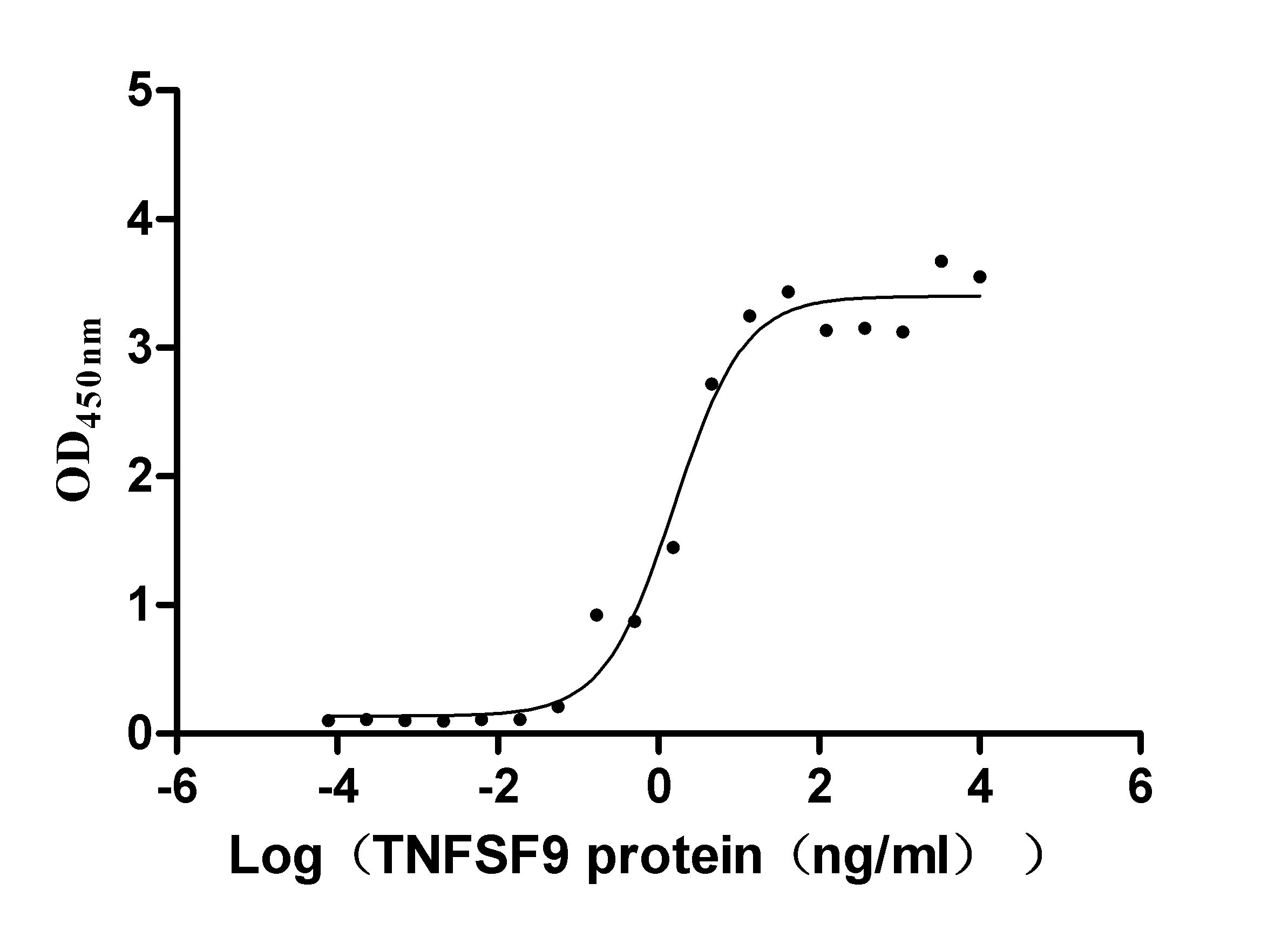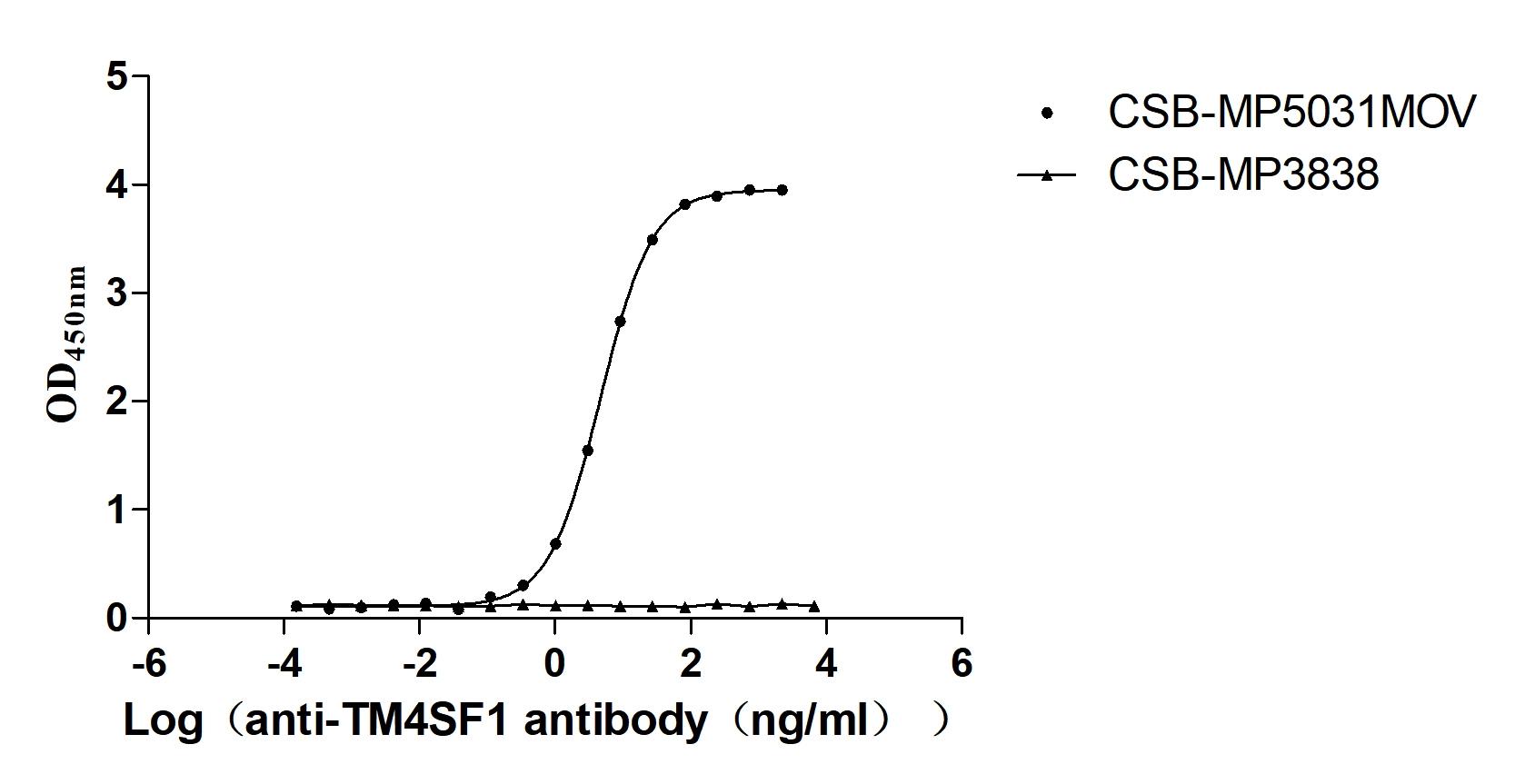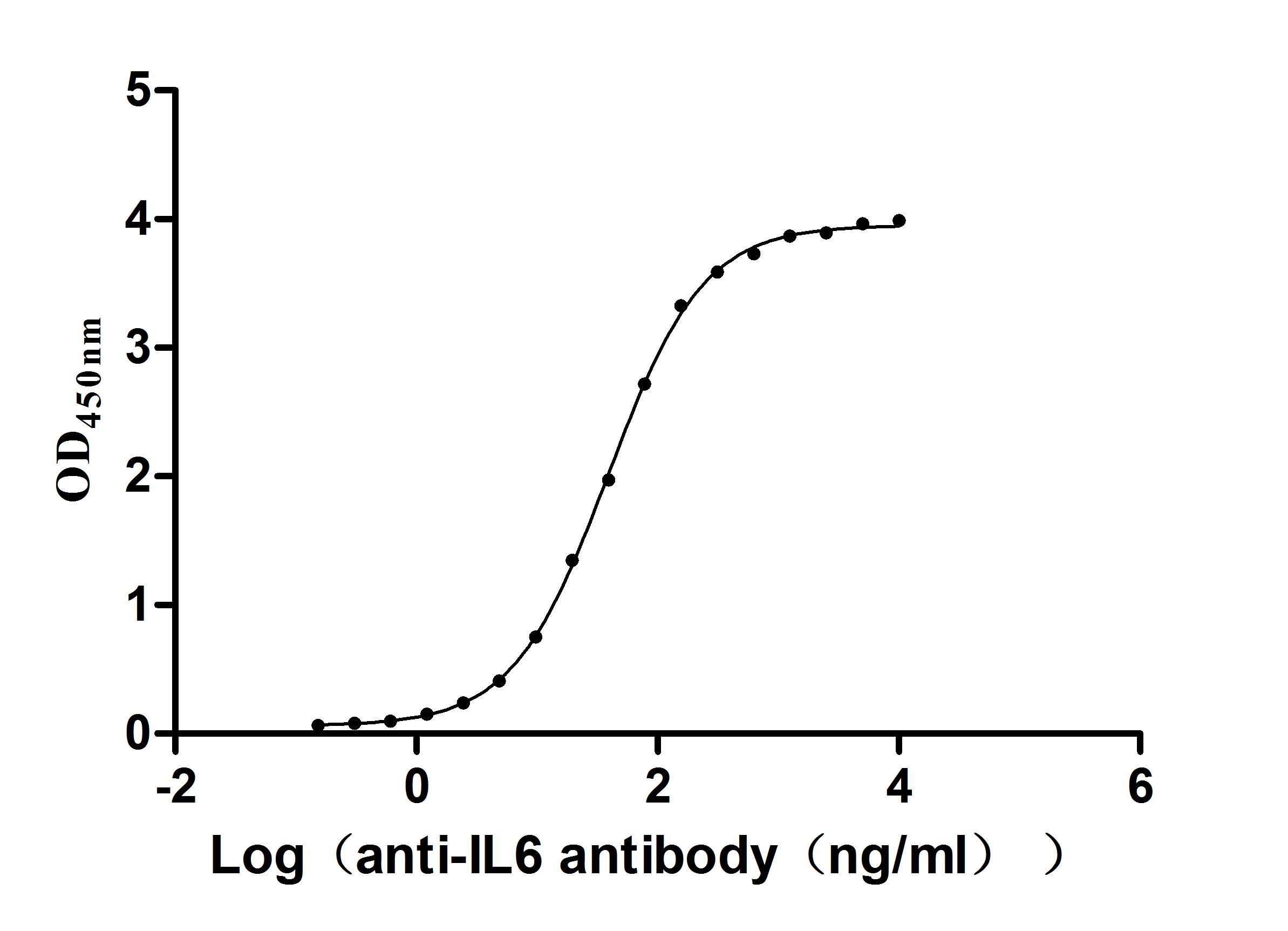Recombinant Human Melanocyte protein PMEL (PMEL), partial
-
中文名称:人PMEL重组蛋白
-
货号:CSB-BP021324HU
-
规格:
-
来源:Baculovirus
-
其他:
-
中文名称:人PMEL重组蛋白
-
货号:CSB-EP021324HU-B
-
规格:
-
来源:E.coli
-
共轭:Avi-tag Biotinylated
E. coli biotin ligase (BirA) is highly specific in covalently attaching biotin to the 15 amino acid AviTag peptide. This recombinant protein was biotinylated in vivo by AviTag-BirA technology, which method is BriA catalyzes amide linkage between the biotin and the specific lysine of the AviTag.
-
其他:
-
中文名称:人PMEL重组蛋白
-
货号:CSB-MP021324HU
-
规格:
-
来源:Mammalian cell
-
其他:
产品详情
-
纯度:Greater than 85% as determined by SDS-PAGE.
-
基因名:
-
Uniprot No.:
-
别名:95 kDa melanocyte specific secreted glycoprotein; 95 kDa melanocyte-specific secreted glycoprotein; D12S53E; gp100; M-beta; ME20; ME20 M/ME20 S; ME20-M; ME20-S; ME20M; ME20M/ME20S; ME20S; Melanocyte lineage specific antigen GP100 ; Melanocyte protein mel 17 ; Melanocyte protein Pmel 17; Melanocyte protein Pmel 17 precursor ; Melanocytes lineage-specific antigen GP100; Melanoma associated ME20 antigen; Melanoma gp100; Melanoma-associated ME20 antigen; Melanosomal matrix protein 17; Melanosomal matrix protein17; P1; p100; p26; PMEL 17; PMEL; PMEL_HUMAN; PMEL17; Premelanosome protein; Secreted melanoma-associated ME20 antigen; SI; SIL; SILV; Silver (mouse homolog) like; Silver homolog; Silver locus protein homolog; Silver, mouse, homolog of
-
种属:Homo sapiens (Human)
-
蛋白长度:Partial
-
表达区域:25-467aa
-
氨基酸序列KVPRNQDWLGVSRQLRTKAWNRQLYPEWTEAQRLDCWRGGQVSLKVSNDGPTLIGANASFSIALNFPGSQKVLPDGQVIWVNNTIINGSQVWGGQPVYPQETDDACIFPDGGPCPSGSWSQKRSFVYVWKTWGQYWQVLGGPVSGLSIGTGRAMLGTHTMEVTVYHRRGSRSYVPLAHSSSAFTITDQVPFSVSVSQLRALDGGNKHFLRNQPLTFALQLHDPSGYLAEADLSYTWDFGDSSGTLISRALVVTHTYLEPGPVTAQVVLQAAIPLTSCGSSPVPGTTDGHRPTAEAPNTTAGQVPTTEVVGTTPGQAPTAEPSGTTSVQVPTTEVISTAPVQMPTAESTGMTPEKVPVSEVMGTTLAEMSTPEATGMTPAEVSIVVLSGTTAAQVTTTEWVETTARELPIPEPEGPDASSIMSTESITGSLGPLLDGTATLRLV
-
蛋白标签:Tag type will be determined during the manufacturing process.
The tag type will be determined during production process. If you have specified tag type, please tell us and we will develop the specified tag preferentially. -
产品提供形式:Lyophilized powder
Note: We will preferentially ship the format that we have in stock, however, if you have any special requirement for the format, please remark your requirement when placing the order, we will prepare according to your demand. -
复溶:We recommend that this vial be briefly centrifuged prior to opening to bring the contents to the bottom. Please reconstitute protein in deionized sterile water to a concentration of 0.1-1.0 mg/mL.We recommend to add 5-50% of glycerol (final concentration) and aliquot for long-term storage at -20℃/-80℃. Our default final concentration of glycerol is 50%. Customers could use it as reference.
-
储存条件:Store at -20°C/-80°C upon receipt, aliquoting is necessary for mutiple use. Avoid repeated freeze-thaw cycles.
-
保质期:The shelf life is related to many factors, storage state, buffer ingredients, storage temperature and the stability of the protein itself.
Generally, the shelf life of liquid form is 6 months at -20°C/-80°C. The shelf life of lyophilized form is 12 months at -20°C/-80°C. -
货期:Delivery time may differ from different purchasing way or location, please kindly consult your local distributors for specific delivery time.Note: All of our proteins are default shipped with normal blue ice packs, if you request to ship with dry ice, please communicate with us in advance and extra fees will be charged.
-
注意事项:Repeated freezing and thawing is not recommended. Store working aliquots at 4°C for up to one week.
-
Datasheet :Please contact us to get it.
相关产品
靶点详情
-
功能:Plays a central role in the biogenesis of melanosomes. Involved in the maturation of melanosomes from stage I to II. The transition from stage I melanosomes to stage II melanosomes involves an elongation of the vesicle, and the appearance within of distinct fibrillar structures. Release of the soluble form, ME20-S, could protect tumor cells from antibody mediated immunity.
-
基因功能参考文献:
- To provide a source of dual-specific T cells for ACT, we generated a transgenic mouse strain expressing a CAR specific for Her2 in leukocytes under the control of the vav promoter .This CAR mouse strain was bred onto the pMEL transgenic mouse strain, expressing a TCR specific for the premelanosome protein, gp100 PMID: 27965307
- IMCgp100 (ImmTAC recognizing a peptide derived from the melanoma-specific protein, gp100, presented by HLA-A*0201) efficiently redirects and activates effector and memory cells from both CD8(+) and CD4(+) repertoires to kill melanoma cells. PMID: 28640942
- our work attempts to provide structural insights into the RPT domain structure and to elucidate its contribution to Pmel17 amyloid fibril formation. PMID: 26754844
- These findings help to clarify the mechanism of T-cell recognition of gp100 during melanoma responses and could direct the development of altered peptides for vaccination. PMID: 26917722
- Data suggest that the Kringle-like domain of PMEL facilitates post-endoplasmic reticulum processing of disulfide-bonded PMEL dimers and promotes formation of PMEL functional amyloid fibrillar structures within multivesicular endosomes. PMID: 26694611
- mutant N-terminally extended peptides exhibited significantly increased HLA-A*02:01 binding affinity and elicited CD8(+) T cell stimulation in vitro similar to the wtgp100209-217 epitope. PMID: 26507656
- Data indicate that repeat domain (RPT) derived from Pmel17 aggregation kinetics were influenced only by lysolipid-containing phospholipid vesicles. PMID: 25451784
- Melanosome-autonomous regulation of size and number: the OA1 receptor sustains PMEL expression. PMID: 24650003
- SIL-TAL1 rearrangement identifies a distinct subtype with inferior outcome which could allow for individual therapeutic stratification for T-ALL patients. PMID: 24040098
- the molecular basis for the distinct trafficking and morphogenetic properties of PMEL and GPNMB is the PKD domain PMID: 23452376
- Data indicat that the N-terminal region of PMEL/Pmel17 is essential for the formation of melanosomal fibrils. PMID: 23389629
- BACE2 cleaves the integral membrane form of PMEL within the juxtamembrane domain, releasing the PMEL luminal domain into endosomal precursors for the formation of amyloid fibrils and downstream melanosome morphogenesis. PMID: 23754390
- The recombinant Pmel 17 plasmids were right as we expected by DNA sequencing PMID: 23643172
- The most significant single-nucleotide polymorphism in the 12q13.2 locus is located immediately upstream of the promoter region of PMEL for vitiligo in Han Chinese. PMID: 22951725
- An antibody drug conjugate reactive with PMEL17 exhibits target-dependent tumor cell killing in vitro and in vivo. PMID: 22613716
- This is a review on two human amyloidogenic polypeptides, one associated with Parkinson's disease, alpha-synuclein (alpha-syn), and the other important for melanin synthesis, the repeat domain (RPT) from Pmel17.[Review] PMID: 21993592
- MART-1- and gp100-expressing and -non-expressing melanoma cells are equally proliferative in tumors and clonogenic in vitro. PMID: 21993558
- Pmel17 repeat domain fibril dissolution is pH dependent PMID: 22092386
- the DW and HoSi mutations alter PMEL TMD oligomerization and/or association with membranes, with consequent formation of aberrantly packed fibrils. PMEL mutations can model the conversion between physiological and pathological amyloid PMID: 21949659
- the multistep processing of Pmel17 begins with an early cleavage during secretion that primes the protein for later functional processing. PMID: 21247888
- Repeat domains of melanosome matrix protein Pmel17 orthologs form amyloid fibrils at the acidic melanosomal pH. PMID: 21148556
- Data suggest that intramelanosomal pH regulates Pmel17 amyloid formation and its subsequent dissolution in vivo. PMID: 21106765
- N-terminal region and the polycystic kidney disease-like domain is highly crucial for endoplasmic reticulum export, subcellular targeting, and fibril formation by Pmel17 and thus for establishing functional melanosomes. PMID: 20231267
- Data conclude that sPmel17 is released by regulated proteolytic ectodomain shedding. PMID: 19884326
- we identified the gp100/pMel17 melanosomal protein as the shared antigen recognized by three independent CD8+ CTL clones in HLA-A*6801-restricted fashion. PMID: 12135425
- Data show that MITF appears to regulate the expression of the SILV and MLANA genes. PMID: 12819038
- Antigen-specific T lymphocyte reactivity to gp100 peptides was seen in 15 of 17 (88%) vitiligo patients, with many demonstrating very high reactivity at levels comparable with those observed with common recall antigens PMID: 12925214
- truncation of the repeat region within Pmel17 alters either fibrillogenic activity or the interaction of Pmel17 with melanin intermediates PMID: 14632201
- CD8 T lymphocytes recognized a nonameric peptide on melanoma cells that comprises two noncontiguous segments of melanocytic glycoprotein gp100(PMEL17); the production of this peptide involves the excision of four amino acids and splicing of the fragments PMID: 15001714
- PMEL17 is rapidly processed in the endoplasmic reticulum and glycosylated in the early Golgi PMID: 15096515
- Data suggest that MART-1 is indispensable for Pmel17 function and thus plays an important role in regulating mammalian pigmentation. PMID: 15695812
- Data show that the melanosomal protein Pmel17 is sorted into intralumenal vesicles by a mechanism that is dependent upon lumenal determinants and conserved in non-pigment cells. PMID: 16516837
- the RPT domain of PMEL17/GP100 is essential for its function in generating the fibrillar matrix of melanosomes and that the luminal domain is necessary for its correct processing and trafficking to those organelles PMID: 16682408
- Pmel17 is a critical component of melanogenesis. PMID: 16704461
- These data reveal a dual sorting defect in a natural mutant of Pmel17 and support a requirement of endocytic trafficking in Pmel17 fibril formation. PMID: 16760433
- addition of sialic acid affects the stability and sorting of Pmel17 and reduces pigmentation PMID: 17303571
- GTP-bound form of Rab7 promotes melanogenesis through the regulation of gp100 maturation in melanoma cells. PMID: 17625594
- Premelanosome amyloid-like fibrils are composed of only golgi-processed forms of Pmel17 that have been proteolytically processed in endosomes PMID: 17991747
- Measurement of Melan-A, gp100, MAGE-3, MIA and tyrosinase represents a prognostic factor and a method for early detection of metastasis and treatment response of melanoma patients. PMID: 18181974
- Tyrosinase-, gp100-, or TRP-2-specific CD8(+) T cells could not be identified in the peripheral blood of individuals with vitiligo. PMID: 18337837
- Nuclear to non-nuclear Pmel17/gp100 expression (HMB45 staining) is a discriminator between benign and malignant melanocytic lesions. PMID: 18552823
- MHC class II presentation of gp100 epitopes in melanoma cells requires the function of conventional endosomes and is influenced by melanosomes. PMID: 19017974
- release of the Pmel17 ectodomain, which is critical for melanin amyloidogenesis, is initiated by S2 cleavage at a juxtamembrane position PMID: 19047044
- the repeat domain of the melanosome fibril protein Pmel17 forms the amyloid core promoting melanin synthesis PMID: 19666488
- N-terminal domains elicit formation of functional Pmel17 amyloid fibrils. PMID: 19840945
- Details and validates the multiple sorting pathways used by the silver protein to reach melanosomes. It identifies the specific adaptor proteins involved and sheds light on the polarization of the melanocyte. PMID: 16492709
- Detailed analysis of the post-translational modifications and their effect over the processing and trafficking of the silv gene. PMID: 17303571
- The PMEL17 (SILV) protein catalyzes the polymerization of 5,6-dihydroxyindole-2-carboxylic acid to melanin. PMID: 8617263
- Pmel17 is proteolytically processed in a post-Golgi compartment and is enriched in multivesicular endosomes prior to incorporation in stage II melanosomes. PMID: 11694580
- A proteolytic fragment of Pmel17, generated by proprotein convertase cleavage, is the major biogenetic component of the underlying fibrillar matrix of melanosome precursors. PMID: 12732614
显示更多
收起更多
-
亚细胞定位:Endoplasmic reticulum membrane; Single-pass type I membrane protein. Golgi apparatus. Melanosome. Endosome, multivesicular body. Note=Identified by mass spectrometry in melanosome fractions from stage I to stage IV. Localizes predominantly to intralumenal vesicles (ILVs) within multivesicular bodies. Associates with ILVs found within the lumen of premelanosomes and melanosomes and particularly in compartments that serve as precursors to the striated stage II premelanosomes.; [M-alpha]: Secreted.
-
蛋白家族:PMEL/NMB family
-
组织特异性:Preferentially expressed in melanomas. Some expression was found in dysplastic nevi. Not found in normal tissues nor in carcinomas. Normally expressed at low levels in quiescent adult melanocytes but overexpressed by proliferating neonatal melanocytes and
-
数据库链接:
HGNC: 10880
OMIM: 155550
KEGG: hsa:6490
STRING: 9606.ENSP00000402758
UniGene: Hs.95972
Most popular with customers
-
Recombinant Human Tumor necrosis factor receptor superfamily member 5 (CD40), partial (Active)
Express system: Mammalian cell
Species: Homo sapiens (Human)
-
Recombinant Human Tumor necrosis factor receptor superfamily member 9 (TNFRSF9), partial (Active)
Express system: Mammalian cell
Species: Homo sapiens (Human)
-
Recombinant Human C5a anaphylatoxin chemotactic receptor 1 (C5AR1)-VLPs (Active)
Express system: Mammalian cell
Species: Homo sapiens (Human)
-
Recombinant Macaca fascicularis Trophoblast glycoprotein (TPBG), partial (Active)
Express system: Mammalian cell
Species: Macaca fascicularis (Crab-eating macaque) (Cynomolgus monkey)
-
Recombinant Macaca fascicularis lymphocyte antigen 6 family member G6D (LY6G6D) (Active)
Express system: Yeast
Species: Macaca fascicularis (Crab-eating macaque) (Cynomolgus monkey)
-
Recombinant Human Serine/threonine-protein kinase receptor R3 (ACVRL1), partial (Active)
Express system: Baculovirus
Species: Homo sapiens (Human)
-
Recombinant Macaca fascicularis Transmembrane 4 L6 family member 1 (TM4SF1)-VLPs (Active)
Express system: Mammalian cell
Species: Macaca fascicularis (Crab-eating macaque) (Cynomolgus monkey)
-




















